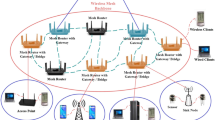Abstract
Hyperbolic radio-location systems possess intrinsic uncertainty that depends on the Node B stations geometry when an iterative positioning algorithm like for instance, Levenberg–Marquardt,is employed to determine an estimate of the mobile station position. This inherent uncertainty arises from the presence of particular areas susceptible to contain local minima inside of it. In this paper, we investigate an optimal geometry for the Node B stations to be involved in such an iterative method. The key factor is to seek such an optimal configuration in the real map to be analysed with the purpose of avoiding any local minima. In this manner, errors in the positioning algorithm are only due to multipath environment and co-channel interference, ensuring that local minima do not affect the result offered by the positioning method. A provisional patent application based on this method has been filed.























Similar content being viewed by others
References
Gustafsson, F., & Gunnarsson, F. (2005). Mobile positioning using wireless networks. IEEE Signal Processing Magazine, 22(4), 41–53.
Roxin, A., Gaber, J., Wack, M., & Nait-Sidi-Moh, A. (2007). Survey of wireless geolocation techniques. In IEEE globecom workshops, pp. 1–9.
3GPP TS 25.305 V3.11.0 (2003-12) Stage 2 funcional specification of user equipment (UE) positioning in UTRAN (Release 1999).
Zhao, Y. (2002). Standardization of mobile phone positioning for 3G systems. IEEE Communications Magazine, 40(7), 108–116.
TS RAN R2.03 V0.1.0 (1999-04). Report on location services (LCS) (1999).
3GPP, TS 36.355 V9.0.0 Release 9. LTE; evolved universal terrestrial radio access (E-UTRA); LTE positioning protocol (LPP).
Osa, V., Matamales, J., Monserrat, J. F., & López, J. (2013). Localization in wireless networks: The potential of triangulation techniques. Wireless Personal Communications, 68(4), 1525–1538.
Sayed, A. H., Tarighat, A., & Khajehnouri, N. (2005). Network-based wireless location: Challenges faced in developing techniques for accurate wireless location information. IEEE Signal Processing Magazine, 22(4), 22–40.
Úbeda, C. (2012). Geo-location technology for UMTS. In J. Ramiro & K. Hamied (Eds.), Self-organizing networks (SON): Self-planning, self-optimization and self-healing for GSM, UMTS and LTE (pp. 263–271). New York: Wiley.
3GPP TS 125.402 V11.0.0 universal mobile telecommunications system (UMTS). Synchronisation in utran stage 2 (2012).
Chan, Y. T., & Ho, K. C. (1994). A simple and efficient estimator for hyperbolic location. IEEE Transactions on Signal Processing, 42(8), 1905–1915.
Roa, J. O., Jiménez, A. R., Seco, F., Prieto, J. C., & Ealo, J. (2007). Optimal placement of sensors for trilateration: Regular lattices vs meta-heuristic solutions. In R. Moreno-Díaz, F. Pichler, & A. Quesada-Arencibia (Eds.), Lecture notes in computer science. Computer Aided Syst. Theory EUROCAST (Vol. 4739, pp. 780–787). Berlin: Springer.
Yarlagadda, R., Ali, I., Al-Dhahir, N., & Hershey, J. (2000). GPS GDOP metric. IEEE Proceedings Radar, Sonar and Navigation, 147(5), 259–264.
García-Fernández, J. A., Jurado-Navas, A., Fernández-Navarro, M., & Úbeda, C. (2014). A comparative study between iterative algorithms for tdoa based geolocation techniques in real umts networks (2014) (submitted for publication).
Jurado-Navas, A., García-Fernández, J. A., Fernández-Navarro, M., & Úbeda, C. (2014). Location of terminals in a communications network. European Patent PCT/EP2014/054875, March, 12, 2014.
Ebrahimian, Z., & Scholtz, R. (2005). Receiver sites for accurate indoor position location systems. In IEEE/ACES international conference on wireless communications and applied computational electromagnetics.
Mensing, C., Plass, S. (2006). Positioning algorithms for cellular networks using tdoa. In IEEE international conference on acoustics, speech and signal processing (ICASSP) proceedings, Vol. 4, pp. IV-513–IV-516.
Weisstein, E. W. (2015). Hyperbola. http://mathworld.wolfram.com/Hyperbola.html. Accessed May 20, 2015.
Acknowledgments
This work was supported by Ericsson.
Author information
Authors and Affiliations
Corresponding author
Rights and permissions
About this article
Cite this article
García-Fernández, J.A., Jurado-Navas, A., Fernández-Navarro, M. et al. Efficient Star-Topology Solving Local Minima for Geolocation in Real UMTS Networks: An Experimental Assessment with Real Data. Wireless Pers Commun 85, 2115–2140 (2015). https://doi.org/10.1007/s11277-015-2895-z
Published:
Issue Date:
DOI: https://doi.org/10.1007/s11277-015-2895-z




